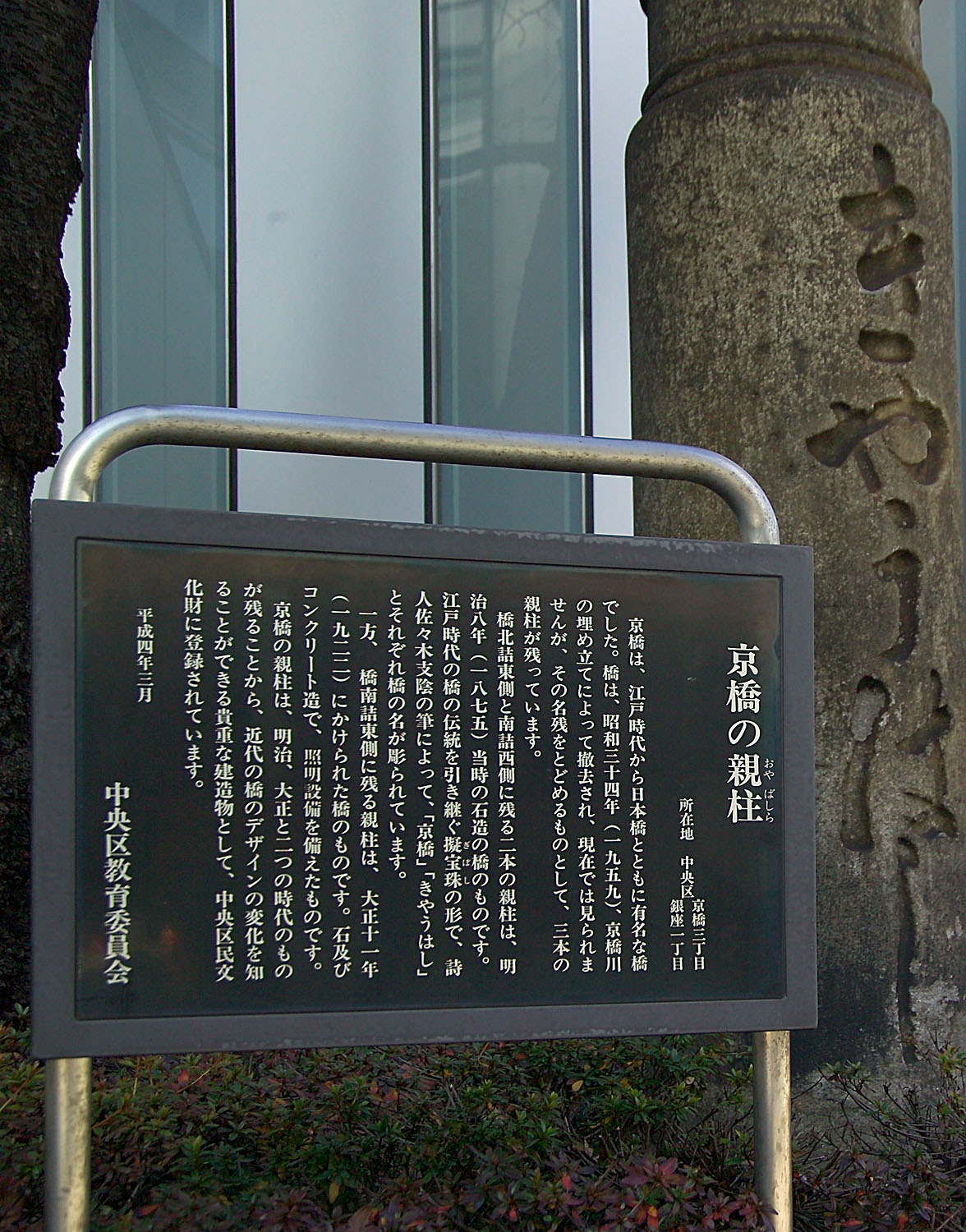Kyōbashi, Tokyo on:
[Wikipedia]
[Google]
[Amazon]

 is a neighborhood east of
is a neighborhood east of
 Its name comes from the bridge that once spanned the Kyōbashi Canal. The south side of the canal was called Takegashi(竹河岸 Bamboo Quay)because it was
Its name comes from the bridge that once spanned the Kyōbashi Canal. The south side of the canal was called Takegashi(竹河岸 Bamboo Quay)because it was
Meidi-Ya
Retrieved on May 13, 2013. "Head Office 2-2-8 Kyobashi, Chuo-ku Tokyo 104-8302"

 is a neighborhood east of
is a neighborhood east of Tokyo Station
Tokyo Station ( ja, 東京駅, ) is a railway station in Chiyoda, Tokyo, Japan. The original station is located in Chiyoda's Marunouchi business district near the Tokyo Imperial Palace, Imperial Palace grounds. The newer Eastern extension is ...
in Chūō, Tokyo
is a Special wards of Tokyo, special ward that forms part of the heart of Tokyo, Japan. The ward refers to itself in English as Chūō City. It was formed in 1947 as a merger of Kyōbashi, Tokyo, Kyobashi and Nihonbashi wards following Tokyo C ...
, Japan. It is one of the city's oldest commercial districts, although it has since been eclipsed by Ginza
Ginza ( ; ja, 銀座 ) is a district of Chūō, Tokyo, located south of Yaesu and Kyōbashi, west of Tsukiji, east of Yūrakuchō and Uchisaiwaichō, and north of Shinbashi. It is a popular upscale shopping area of Tokyo, with numerous intern ...
to the south and Nihonbashi
is a business district of Chūō, Tokyo, Japan which grew up around the bridge of the same name which has linked two sides of the Nihonbashi River at this site since the 17th century. The first wooden bridge was completed in 1603. The current ...
to the north.
Kyobashi, together with Nihonbashi and Kanda
Kanda may refer to:
People
* Kanda (surname)
*Kanda Bongo Man (born 1955), Congolese soukous musician
Places
* Kanda, Tokyo, an area in Chiyoda-ku, Tokyo, Japan
**Kanda Station (Tokyo), a railway station in Chiyoda-ku, Tokyo
* Kanda River, a ri ...
, is the core of Shitamachi, the original downtown center of Edo-Tokyo, before the rise of newer secondary centers such as Shinjuku
is a special ward in Tokyo, Japan. It is a major commercial and administrative centre, housing the northern half of the busiest railway station in the world (Shinjuku Station) and the Tokyo Metropolitan Government Building, the administration ...
and Shibuya
Shibuya ( 渋谷 区 ''Shibuya-ku'') is a special ward in Tokyo, Japan. As a major commercial and finance center, it houses two of the busiest railway stations in the world, Shinjuku Station (southern half) and Shibuya Station.
As of April 1 ...
.
History
 Its name comes from the bridge that once spanned the Kyōbashi Canal. The south side of the canal was called Takegashi(竹河岸 Bamboo Quay)because it was
Its name comes from the bridge that once spanned the Kyōbashi Canal. The south side of the canal was called Takegashi(竹河岸 Bamboo Quay)because it was bamboo
Bamboos are a diverse group of evergreen perennial flowering plants making up the subfamily Bambusoideae of the grass family Poaceae. Giant bamboos are the largest members of the grass family. The origin of the word "bamboo" is uncertain, bu ...
wholesalers' area.
The Kyōbashi, or Capital Bridge, linked the Ginza
Ginza ( ; ja, 銀座 ) is a district of Chūō, Tokyo, located south of Yaesu and Kyōbashi, west of Tsukiji, east of Yūrakuchō and Uchisaiwaichō, and north of Shinbashi. It is a popular upscale shopping area of Tokyo, with numerous intern ...
and the Kyōbashi neighborhood. According to the sign erected at the site by the Chuo-ku Board of Education, together with Nihonbashi, it was one of the famous bridges of Edo. When the canal was filled in 1959, the bridge was removed. Today, a pillar stands to mark the site of the old bridge.
Kyobashi was also a ward of Tokyo City
was a Cities of Japan, municipality in Japan and part of Tokyo Prefecture (1868–1943), Tokyo-fu which existed from 1 May 1889 until its merger with its prefecture on 1 July 1943. The historical boundaries of Tokyo City are now occupied by ...
, encompassing 16 neighborhoods, including Ginza, Tsukiji
Tsukiji (築地) is a district of Chūō, Tokyo, Japan. Literally meaning "reclaimed land", it lies near the Sumida River on land reclaimed from Tokyo Bay in the 18th century during the Edo period. The eponymous Tsukiji fish market opened in 193 ...
, and Tsukishima
is a place located in Chūō, Tokyo, Japan, in the Sumida River estuary. It is a reclaimed land next to Tsukuda District. The land reclamation completed in 1892, using earth from the dredging work performed to create a shipping channel in Toky ...
, in addition to Kyobashi itself. In 1947, when the 35 wards of Tokyo were reorganized into 23, it was merged with Nihonbashi to form the modern Chuo ward.
Transportation
Kyōbashi and Takarachō stations provide subway service.Corporate tenants
Meidi-Ya
is a Japanese upmarket grocery store
A grocery store ( AE), grocery shop ( BE) or simply grocery is a store that primarily retails a general range of food products, which may be fresh or packaged. In everyday U.S. usage, however, "grocer ...
, an upscale grocery store chain, has its headquarters in this area.Retrieved on May 13, 2013. "Head Office 2-2-8 Kyobashi, Chuo-ku Tokyo 104-8302"
Education
Public elementary and junior high schools are operated by Chuo City Board of Education. The zoned schools are Joto Elementary School ( 中央区立城東小学校) and Ginza Junior High School ( 中央区立銀座中学校)Notable people
Ryūnosuke Akutagawa
, art name , was a Japanese writer active in the Taishō period in Japan. He is regarded as the "father of the Japanese short story", and Japan's premier literary award, the Akutagawa Prize, is named after him. He committed suicide at the age of ...
, the "father of the modern Japanese short-story", was born here.
References
Neighborhoods of Tokyo Chūō, Tokyo {{Tokyo-geo-stub